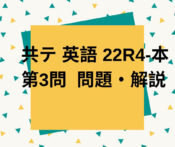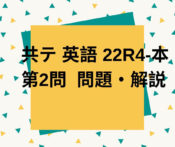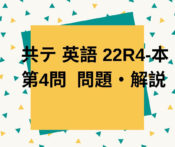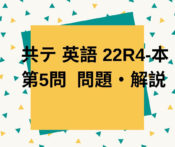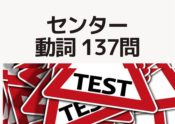共通テスト英語2022(令和4) 第6問B 問題&詳細解説
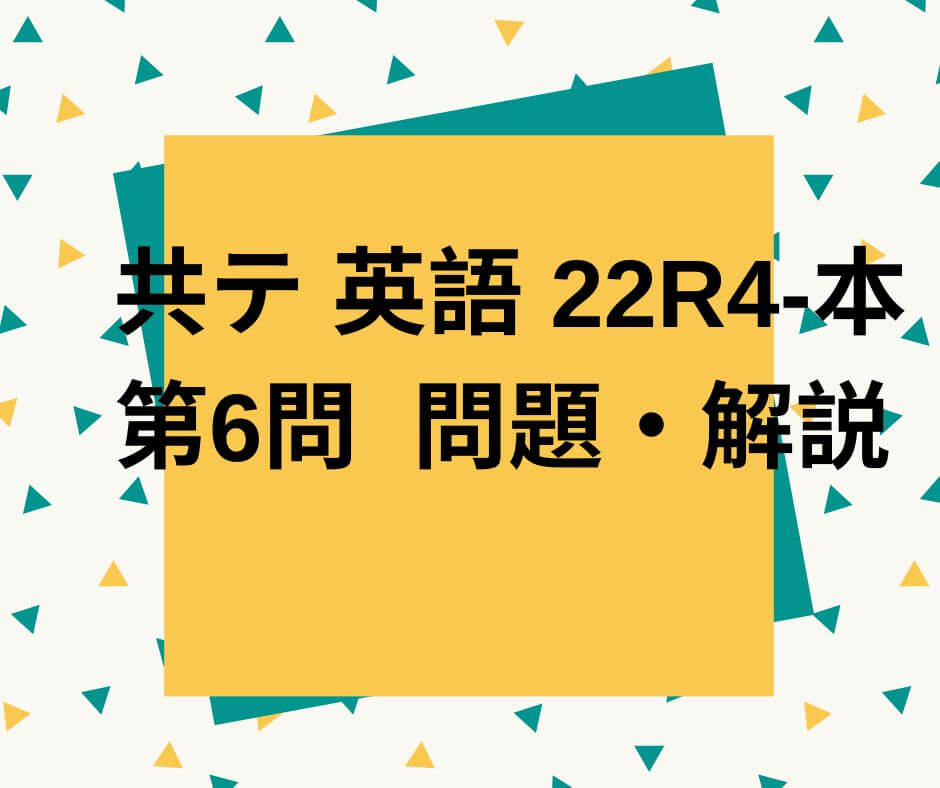
大手予備校で中1から高3の基礎クラスから東大クラスまでほとんどのクラスを担当しました。映像授業にも多数出演経験あり。
元東海大非常勤講師。
「大学入試英語解く得!」は最高PV数 34,212 / 日
質・量ともに日本一分かりやすい大学入試英語対策ページを目指します!
資格:英検一級、通訳案内士(英語)、TOEIC950点
趣味:海外旅行、食べ歩き
特技:将棋アマ六段 (全国レーティング選手権優勝 1998)
元技術翻訳者、元富士通
英語2022 (令和4) 第6問B-問題
B You are in a student group preparing a poster for a scientific presentation contest with the theme “What we should know in order to protect the environment.” You have been using the following passage to create the poster.
Recycling Plastic
― What You Need to Know ―
The world is full of various types of plastic. Look around, and you will see dozens of plastic items. Look closer and you will notice a recycling symbol on them. In Japan, you might have seen the first symbol in Figure 1 below, but the United States and Europe have a more detailed classification. These recycling symbols look like a triangle of chasing pointers, or sometimes a simple triangle with a number from one to seven inside. This system was started in 1988 by the Society of the Plastics Industry in the US, but since 2008 it has been administered by an international standards organization, ASTM (American Society for Testing and Materials) International. Recycling symbols provide important data about the chemical composition of plastic used and its recyclability. However, a plastic recycling symbol on an object does not always mean that the item can be recycled. It only shows what type of plastic it is made from and that it might be recyclable.

So, what do these numbers mean? One group (numbers 2, 4, and 5) is considered to be safe for the human body, while the other group (numbers 1, 3, 6, and 7) could be problematic in certain circumstances. Let us look at the safer group first.
High-density Polyethylene is a recycle-type 2 plastic and is commonly called HDPE. It is non-toxic and can be used in the human body for heart valves and artificial joints. It is strong and can be used at temperatures as low as -40°C and as high as 100°C. HDPE can be reused without any harm and is also suitable for beer-bottle cases, milk jugs, chairs, and toys. Type 2 products can be recycled several times. Type 4 products are made from Low-density Polyethylene (LDPE). They are safe to use and are flexible. LDPE is used for squeezable bottles, and bread wrapping. Currently, very little Type 4 plastic is recycled. Polypropylene (PP), a Type 5 material, is the second-most widely produced plastic in the world. It is light, non-stretching, and has a high resistance to impact, heat, and freezing. It is suitable for furniture, food containers, and polymer banknotes such as the Australian dollar. Only 3% of Type 5 is recycled.
Now let us look at the second group, Types 1, 3, 6, and 7. These are more challenging because of the chemicals they contain or the difficulty in recycling them. Recycle-type 1 plastic is commonly known as PETE (Polyethylene Terephthalate), and is used mainly in food and beverage containers. PETE containers ― or PET as it is often written in Japan ― should only be used once as they are difficult to clean thoroughly. Also, they should not be heated above 70°C as this can cause some containers to soften and change shape. Uncontaminated PETE is easy to recycle and can be made into new containers, clothes, or carpets, but if PETE is contaminated with Polyvinyl Chloride (PVC), it can make it unrecyclable. PVC, Type 3, is thought to be one of the least recyclable plastics known. It should only be disposed of by professionals and never set fire to at home or in the garden. Type 3 plastic is found in shower curtains, pipes, and flooring. Type 6, Polystyrene (PS) or Styrofoam as it is often called, is hard to recycle and catches fire easily. However, it is cheap to produce and lightweight. It is used for disposable drinking cups, instant noodle containers, and other food packaging. Type 7 plastics (acrylics, nylons, and polycarbonates) are difficult to recycle. Type 7 plastics are often used in the manufacture of vehicle parts such as seats, dashboards, and bumpers.
Currently, only about 20% of plastic is recycled, and approximately 55% ends up in a landfill. Therefore, knowledge about different types of plastic could help reduce waste and contribute to an increased awareness of the environment.
Your presentation poster draft :
Do you know the plastic recycling symbols?
What are plastic recycling symbols?
( 44 )
Types of plastic and recycling information
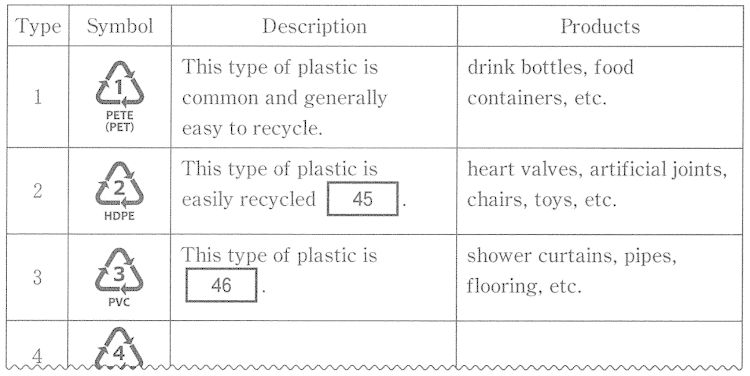
Plastics with common properties
( 47 )
( 48 )
問1 Under the first poster heading, your group wants to introduce the plastic recycling symbols as explained in the passage. Which of the following is the most appropriate?
( 44 )
① They are symbols that rank the recyclability of plastics and other related problems.
② They provide information on the chemical make-up and recycling options of the plastic.
③ They tell the user which standards organization gave them certificates for general use.
④ They were introduced by ASTM and developed by the Society of the Plastics Industry.
問2 You have been asked to write descriptions of Type 2 and Type 3 plastics. Choose the best options for ( 45 ) and ( 46 ).
Type 2 ( 45 )
① and commonly known as a single-use plastic
② and used at a wide range of temperatures
③ but harmful to humans
④ but unsuitable for drink containers
Type 3 ( 46 )
① difficult to recycle and should not be burned in the yard
② flammable; however, it is soft and cheap to produce
③ known to be a non-toxic product
④ well known for being easily recyclable
問3 You are making statements about some plastics which share common properties. According to the article, which two of the following are appropriate? (The order does not matter.) ( 47 ) ・ ( 48 )
① Boiling water (100°C) can be served in Type 1 and Type 6 plastic containers.
② It is easy to recycle products with Type 1, 2, and 3 logos.
③ Products with the symbols 1, 2, 4, 5, and 6 are suitable for food or drink containers.
④ Products with Type 5 and Type 6 markings are light in weight.
⑤ Type 4 and 5 plastics are heat resistant and are widely recycled.
⑥ Type 6 and 7 plastics are easy to recycle and environmentally friendly.
英語2022(令和4) 第6問B-解答・解説
第6問B 問1 解答
問1 Under the first poster heading, your group wants to introduce the plastic recycling symbols as explained in the passage. Which of the following is the most appropriate? ( 44 )
最初のポスターの見出しの下に、あなたのグループはこの一節で説明されているようにプラスチックのリサイクル記号を紹介したいと考えている。次のうちどれが最も適切であるか。( 44 )
① They are symbols that rank the recyclability of plastics and other related problems.
それらはプラスチックのリサイクル可能性とその他の関連する問題を順位付ける記号だ。
② They provide information on the chemical make-up and recycling options of the plastic.
それらはプラスチックの化学構成とリサイクルの選択肢に関する情報を提供する。
③ They tell the user which standards organization gave them certificates for general use.
それらは一般的に使用するためにどの標準化団体が使用者にそれらに証明書を発行したかを伝える。
④ They were introduced by ASTM and developed by the Society of the Plastics Industry.
それらはASTMによって導入され,プラスチック工業協会によって開発された。
リサイクル記号については第一段落の最終から第3文に
Recycling symbols provide important data about the chemical composition of plastic used and its recyclability.
「リサイクル記号は使用されるプラスチックの化学構成とそのリサイクル可能性に関する重要なデータを提供する」
とあるので②が正解。
ここではmake-upの言い換えがcompositionですね。
 しげT
しげT
第6問B 問2 解答
問2 You have been asked to write descriptions of Type 2 and Type 3 plastics. Choose the best options for ( 45 ) and ( 46 ). あなたはタイプ2とタイプ3のプラスチックの説明を書くように頼まれた。( 45 )と( 46 )に当てはまる最も適当な選択肢を選べ。
Type 2 ( 45 )
① and commonly known as a single-use plastic また一般的に使い捨てプラスチックとして知られている
② and used at a wide range of temperatures また幅広い温度で使用される
③ but harmful to humans しかし人体に有害である
④ but unsuitable for drink containers しかし飲料の容器には適さない
Type2の説明は第三段落冒頭から。第三段落の第3文に
It is strong and can be used at temperatures as low as -40°C and as high as 100°C.
「それ(タイプ2のプラスチック)は丈夫で-40℃の低温と100℃の高温で使用できる」とあるので②が正解。
Type 3 ( 46 )
① difficult to recycle and should not be burned in the yard リサイクルが難しく、庭で燃やすべきではない
② flammable; however, it is soft and cheap to produce 燃やすことができるが、柔らかく、安価に生産できる
③ known to be a non-toxic product 無毒な製品として知られている
④ well known for being easily recyclable リサイクルしやすいことでよく知られている
Type3の説明は第四段落中頃から
PVC, Type 3, is thought to be one of the least recyclable plastics known. It should only be disposed of by professionals and never set fire to at home or in the garden.
「PVC、タイプ3は知られているものの中で最もリサイクルできないプラスチックの1つと考えられている。それは専門家によってのみ処分され、決して家や庭で火をつけてるべきではない」
とあるので①が正解。
第6問B 問3 解答
問3 You are making statements about some plastics which share common properties. According to the article, which two of the following are appropriate? (The order does not matter.) ( 47 ) ・ ( 48 )
あなたは特性を共有するプラスチックについての意見を書いている。この記事によると、次のうち2つの適切なものはどれか。(順番は不問) ( 47 )・( 48 )
① Boiling water (100°C) can be served in Type 1 and Type 6 plastic containers.
沸騰水(100℃)は、タイプ1およびタイプ6のプラスチック容器で使うことができる。
② It is easy to recycle products with Type 1, 2, and 3 logos.
タイプ1、2、3のロゴがある製品はリサイクルが容易である。
③ Products with the symbols 1, 2, 4, 5, and 6 are suitable for food or drink containers.
記号1、2、4、5、6の製品は食品や飲料の容器に適している。
④ Products with Type 5 and Type 6 markings are light in weight.
タイプ5とタイプ6の印のある製品は軽量である。
⑤ Type 4 and 5 plastics are heat resistant and are widely recycled.
タイプ4および5のプラスチックは耐熱性があり、広くリサイクルされている。
⑥ Type 6 and 7 plastics are easy to recycle and environmentally friendly.
タイプ6と7のプラスチックはリサイクルが容易で環境に優しい。
① タイプ1は70℃までしか耐えられないので不適当。
タイプ1に関する説明で
Also, they should not be heated above 70°C
70度以上に加熱すべきでない事が書かれている。
➁ タイプ3は問2でリサイクルが最も難しいことが分かったので不適当。
③ タイプ3もタイプ7もはリサイクルに適さず、どこで使われているかは書かれているが、具体的なリサイクル例は書かれていない。
他のタイプはそれぞれに食品や飲料でリサイクルされている記述がある。
④ タイプ5はlight、タイプ6はlightweightという記述があるので正解。
⑤ タイプ4は
Currently, very little Type 4 plastic is recycled.
タイプ5は
Only 3% of Type 5 is recycled.
という記述があるので、どちらもほとんどリサイクルされていない。
⑥ タイプ6もタイプ7もリサイクルが難しいので不適当。
タイプ6はhard to recycle、タイプ7はdifficult to recycleと書かれている。
大手予備校で中1から高3の基礎クラスから東大クラスまでほとんどのクラスを担当しました。映像授業にも多数出演経験あり。
元東海大非常勤講師。
「大学入試英語解く得!」は最高PV数 34,212 / 日
質・量ともに日本一分かりやすい大学入試英語対策ページを目指します!
資格:英検一級、通訳案内士(英語)、TOEIC950点
趣味:海外旅行、食べ歩き
特技:将棋アマ六段 (全国レーティング選手権優勝 1998)
元技術翻訳者、元富士通


